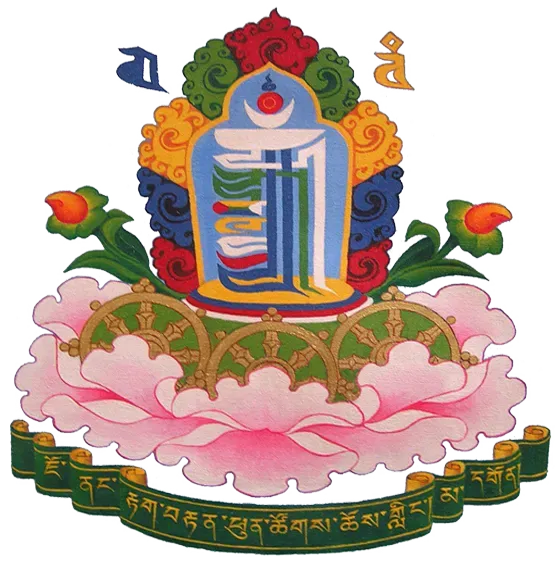Drigung Lotsāwa (‘bri gung lo tsA ba) was born in Gyerpu (gyer phu) in 1289. He began formal studies at Sangpu Monastery (gsang phu), where he received the vows of a novice monk and the name Norbu Pel Yeshe (nor bu dpal ye shes). He was later widely known by the Sanskrit form of this name, Maṇikaśrījñāna.
After studying at many monasteries in U-Tsang, he traveled to the great monastery of Sakya (sa skya) in Tsang, where he became expert in the vehicle of the perfections, epistemology, and abhidharma under a master named Jamyang Chokyi Gyeltsen (‘jam dbyangs chos kyi rgyal mtshan). Next he went to Drakram Monastery (brag ram) where he received full ordination from the abbot Konchok Sangpo (dkon mchog bzang po) and mastered the scriptures of the monastic code. He also studied Sanskrit grammar and poetics under the great scholar Buton Rinchen Drub (bu ston rin chen grub, 1290–1364) at Zhalu Monastery (zhwa lu).
Maṇikaśrījñāna then visited the large Kagyu monastery of Drigung (‘bri gung) in Tibet. There he studied Indian languages, Sanskrit grammar, and Indian scripts under the guidance of the Indian paṇḍita Dvaṣṭanakara (dwa ShTa na ka ra), after which he became known as Drigung Lotsāwa (‘bri gung lo tsA ba), Translator of Drigung. He also studied the spoken dialects of the eastern and western regions of India under the Indian acārya Vatikara (a tsa ra wa ti ka ra). From the holder of the monastic seat at Drigung, he received countless special teachings, such as the Six Dharmas of Niguma, the Six Dharmas of Nāropa, and Mahāmudrā instructions. After some time he was appointed to the abbacy of Drigung, and all the books, images, and so forth of the former abbots were offered to him. He lived and taught at Drigung for five years.
Drigung Lotsāwa then heard the news that Dolpopa Sherab Gyeltsen (dol po pa shes rab rgyal mtshan, 1292-1361) had come to U-Tsang and established his large encampment at Nyetang Monastery (snye thang). He went to Nyetang, where a huge number of people had gathered from U and Tsang, and met Dolpopa. According to his hagiography, when he conversed with Dolpopa, he felt like he was just a firefly in the presence of the sun, and from that time remained constantly with the great Jonang master. He received from Dolpopa the Kālacakra initiation and various instructions of the six-branch yoga of Kālacakra, for which he later wrote instruction manuals. He eventually received all the exoteric and esoteric teachings from Dolpopa, such as the Vimalaprabhā on sixteen different occasions.
After the Dolpopa passed away in 1361, Drigung Lotsāwa retired to a hermitage called Drakkar Choteng (brag dkar chos steng), where he mostly stayed in meditation, although he also taught many disciples epistemology and the Vimalaprabhā over a period of three years. At the urging of the Sengetse ruler (seng ge rtse ba), Drigung Lotsāwa once gave the Kālacakra initiation of the Dro (‘bro) tradition to about three hundred monks, at which time, it is said, the sky was filled with rainbow light, a rain of flowers fell, and everyone saw him place his bell and vajra in space and levitate with both feet above the ground.
He then traveled to the Nyangto (nyang stod) region, where Nyawon Kunga Pel (nya dbon kun dga’ dpal, 1285-1379), who was also one Dolpopa’s major disciples, invited him to Tsechen Monastery (rtse chen dgon). He was also invited to the palace at Gyantse, where he gave teachings to the ruler for one month. At the end of this visit, Drigung Lotsāwa debated twenty-five expert scholars for four days, defeating them and thus spreading the doctine of the zhentong (gzhan stong) view.
Then he was invited to Jonang Monastery (jo nang dgon), where he wept in remembrance of Dolpopa’s kindness and experienced a vision in which he clearly saw the one-thousand-arm form of Avalokiteśvara at Dolpopa’s great stupa. He remained at Jonang for eight years, during which the holder of the monastic seat gave the morning teaching to the assembly and taught the Vimalaprabhā as the afternoon teaching. When he had reached the age of seventy-two, and it was difficult for him to sit and walk, he still accepted an invitation to the hermitage of Khading Pungpo (mkha’ lding phung po), where he taught the Vimalaprabhā for two years.
At the age of seventy-five, Drigung Lotsāwa passed away, after having sent all the offerings from his teachings to the great stupa at Jonang. Many miraculous events were said to have occurred following his death and during the cremation, and that wonderful relics were found in his bones.



